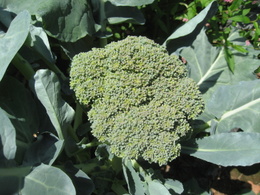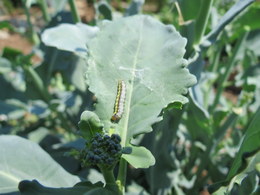Broccoli Growing Guide
Broccoli (Brassica oleracea) is one of the cruciferous vegetables you should eat on a regular basis and is an important source of essential nutrients and fiber.
It contains a compound called sulforaphane. Sulforaphane belongs to a group of phytochemicals that are reported to be helpful in the prevention of cancer.
A partial list of common cruciferous vegetables is: bok choy (Chinese cabbage), broccoli, Brussels sprouts, cabbage, cauliflower, collard greens, kale, kohlrabi and radish.
Artwork is a new variety that won the 2015 All-America Selections award. You may see it described as ‘Stir-Fry’ or ‘Baby’ broccoli. When the main central head is about 1.5 to 2-inches in diameter it should be removed. The plant will now produce many baby side shoots all summer long. Staking the broccoli plant will help keep it from falling over.
Starting From Seed
Follow the seed packet instructions, seeds can be started indoors 6 to 8-weeks before your last expected frost date.
For more detailed information visit the seed starting page.
Soil Preparation
Broccoli should be planted in full sun and in a nice loose well-drained garden soil. It will do well in slightly acid to alkaline soil with a pH range of 6.0 to 7.5.
As soon as the soil is frost-free and can be worked, till the soil by digging down 8 to 12-inches turning the soil over with a garden fork. Remove any large rocks, the small pebbles remaining will do no harm and actually benefit the soil by adding some micronutrients to the soil.
Planting Broccoli
Broccoli is a cool weather annual vegetable and can be planted 2-weeks before your last expected frost. Plant it in an area so that it gets 6 to 8-hours of sunlight. Broccoli can be planted as close as 12-inches apart, but they will be a bit crowded, so a spacing of 18 to 24-inches will give them more room.
Water the plants deeply once a week to keep the shallow roots from drying out, especially when the heads are forming.
Mulching
When it is established a nice loose mulch of shredded leaves or pine straw will help shade the broccoli roots. This will keep the weeds out, the soil cooler and keep it from drying out.
Harvesting
Be sure to pick it while the flower buds are still tightly closed. Remove the head with a sharp knife leaving a stem 1 to 2-inches long. After picking the head the plant will send out more side shoots with smaller heads for an extended harvest.
If you should see any aphids or cabbage worms on the head soak the head for 15-minutes in warm water with some vinegar in it. This should drive them out before cooking.
Diseases
There are several diseases that affect the cruciferous vegetables. These occasionally affect the roots and leaves. Crop rotation and removal of diseased plants is the best way to control them. Increasing plant spacing in the future helps increase air circulation around the plants.
Pests
Most of the cruciferous vegetables are all affected by many of the same pests. Some of these are: aphids and several species of cabbageworms and caterpillars.
The easiest way to deal with aphids without using chemicals is to knock them off with a spray of water. Ladybug beetles will eat many aphids. Many gardeners will purchase them and release them in their garden to help control the aphids that are a problem with many plants. Serious infestations can be controlled with an organic product such as insecticidal soap or neem oil. These are both organic controls that are very effective.
The cabbageworms and caterpillars cause damage by eating holes in the leaves. The adult moth lays small eggs on the underside of the leaves, which hatch out as larvae and do the damage. They multiply very rapidly, so inspect your plants often early in the morning, between the leaves and the underside for small caterpillars and egg masses.
Cabbageworms can be removed by hand picking them as you inspect your plants. Spraying your plants every 1 or 2-weeks with a special variety of BT (Bacillus thuringiensis var. kurstaki) will kill the cabbageworms. There are also several products that contain spinosad, a naturally occurring insecticide.
Duct tape helps to remove the caterpillars and eggs. Take a piece about 8 or 9-inches long and attach the ends together to form a loop with the sticky side out. Put one hand through the loop and with the other lift up a leaf looking for any caterpillars or eggs. If you find any caterpillars stick them to the tape and do the same for the eggs.
Cabbage root maggot larvae feed on the roots of the plants, which in the beginning causes wilting and plants to die later on. The best prevention is to toss the entire plant in the garbage after harvesting, including any soil that clings to the roots. The best way to reduce any future problems is to rotate your crops to a new location each year. Row covers are about the only way to control the cabbage root fly. Place the row covers over the plants in the spring right after putting them in the ground.
Popular Varieties
Popular varieties: Artwork, Calabrese, Goliath, Liberty, Lieutenant, Marathon, Packman, Premium Crop.
Sources: Seeds Now, Johnny’s Selected Seeds, Park Seed
Tips and Warnings
It is very important not to overcook broccoli or any of the other cruciferous vegetables. They have sulforaphane in them, which is a sulfur compound that is essential for life. When broccoli and other cruciferous vegetables are overcooked they will emit an unpleasant sulfur smell, which is why many people do not like collard greens, broccoli, cauliflower or cabbage.
The best and most nutritious way to cook broccoli is to steam it instead of boiling. Put a small amount of water in a pot and bring to a boil. Add your steamer basket and the broccoli. Set your timer and simmer covered for 8 to 10-minutes. Adjust the time to your own personal taste, it does not need to be cooked until limp and wilted.
If you forgot to pick your broccoli and it became a nice head of yellow flowers, you can leave it and let the bees enjoy them.
Garden Spikes newsletters give you timely information once or twice a month. Subscribe Free to the Garden Times newsletter below.
Your email address will only be used to send you a newsletter and will never be sold. You can unsubscribe at any time.


